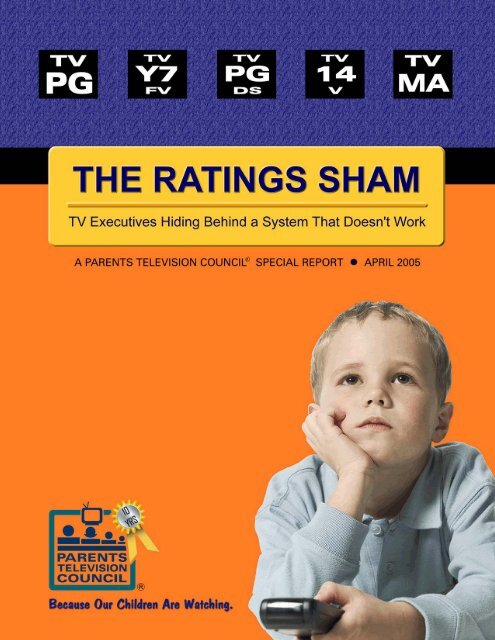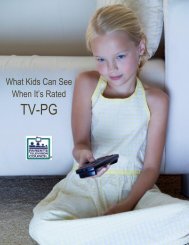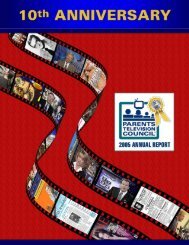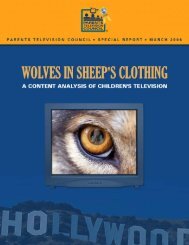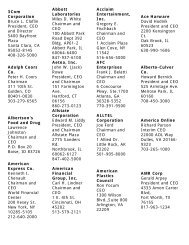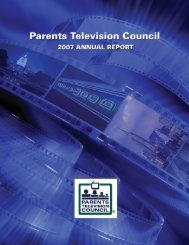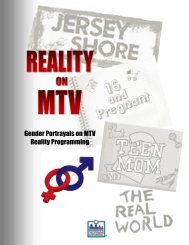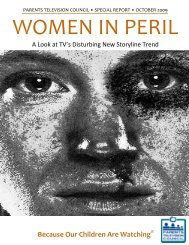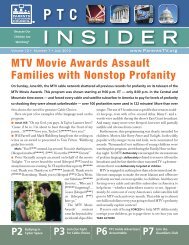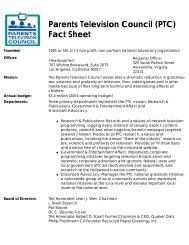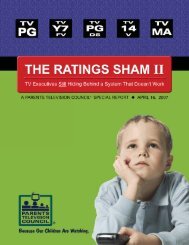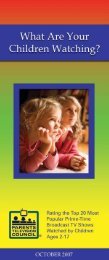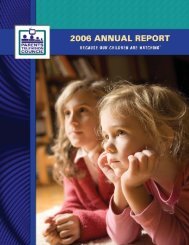The Ratings Sham - Parents Television Council
The Ratings Sham - Parents Television Council
The Ratings Sham - Parents Television Council
Create successful ePaper yourself
Turn your PDF publications into a flip-book with our unique Google optimized e-Paper software.
A P A R E N T S T E L E V I S I O N C O U N C I L S P E C I A L R E P O R T • A P R I L 2005<br />
THE RATINGS SHAM<br />
TV Executives Hiding Behind a System That Doesn’t Work<br />
EXECUTIVE SUMMARY<br />
This is the <strong>Parents</strong> <strong>Television</strong> <strong>Council</strong>’s fourth<br />
report examining the television ratings system. <strong>The</strong><br />
others, released in 1997, ’98, and ’99, when the<br />
ratings system was still relatively new, all documented<br />
how it was a failure. Nearly nine years after its<br />
creation, the TV ratings system is still a mess – and<br />
arguably worse than ever. For example, last year’s<br />
Super Bowl was given a TV-G rating, but even if<br />
Janet Jackson’s allegedly unplanned breast exposure<br />
had not occurred, the other performances during<br />
the halftime show would have warranted giving the<br />
broadcast at least a TV-PG rating. Even while TV<br />
content continues to coarsen, the ratings are often<br />
inconsistent and inaccurate, and are of little help to<br />
parents trying to make informed and appropriate<br />
viewing decisions for their families.<br />
For this study, the PTC examined prime time<br />
entertainment programs from the first two weeks of<br />
the November 2003, February 2004, and May 2004<br />
sweeps on the seven commercial broadcast<br />
networks (ABC, CBS, Fox, NBC, Pax, UPN, and the<br />
WB). <strong>The</strong>se weeks traditionally have mostly original<br />
programming, which typically means a high level of<br />
indecent material as networks attempt to boost<br />
ratings. <strong>The</strong> study period comprised 638 shows, and<br />
a total of 528 hours.<br />
<strong>The</strong> PTC found that every network had<br />
problems with the accurate and consistent<br />
application of content descriptors (a D, S, L, or V<br />
indicating the presence of suggestive dialogue,<br />
sexual behavior, foul language, or violence).<br />
OTHER FINDINGS:<br />
✔<br />
To this day, NBC still does not use content<br />
descriptors on its programs. Moreover, 36%<br />
of NBC’s programs reviewed for this study<br />
✔<br />
✔<br />
✔<br />
✔<br />
✔<br />
✔<br />
received a TV-PG rating, even though many<br />
of these shows contained foul language and<br />
adult sexual content.<br />
Of the 85 PG-rated shows on ABC, 52% were<br />
missing necessary content descriptors. 40%<br />
of the PG-rated shows containing foul<br />
language lacked an L descriptor; 75% of shows<br />
containing violence lacked the V descriptor;<br />
60% of the shows containing sexual dialogue<br />
lacked the D descriptor; and 92% of the shows<br />
containing sexual behavior lacked the S<br />
descriptor.<br />
73% of ABC’s TV-14-rated shows lacked<br />
appropriate content descriptors.<br />
CBS fared better than ABC with the content<br />
descriptors, but still has plenty of room for<br />
improvement. Of the 89 shows given a PG<br />
rating, 34% of the shows containing foul<br />
language lacked an L descriptor; 44% of the<br />
shows containing violence lacked the V<br />
descriptor; 57% of the shows containing<br />
sexual dialogue lacked the D descriptor; and<br />
none of the 19 shows containing sexual<br />
behavior featured the S descriptor.<br />
81% of CBS’s TV-14-rated shows containing<br />
sexual dialogue lacked the D descriptor.<br />
On the WB network, of the 49 PG-rated shows<br />
containing foul language, 59% lacked an L<br />
descriptor. Of the 26 PG-rated shows<br />
containing violence, 35% lacked the V<br />
descriptor. Of the 50 PG-rated shows with<br />
sexual dialogue, 64% lacked the D descriptor.<br />
82% of WB’s TV-14-rated shows containing<br />
sexual behavior lacked the S descriptor.
2 THE RATINGS SHAM: TV Executives Hiding Behind a System That Doesn’t Work • <strong>Parents</strong> <strong>Television</strong> <strong>Council</strong> • April 2005<br />
✔<br />
✔<br />
✔<br />
✔<br />
On Fox, 43% of the shows were missing<br />
appropriate content descriptors. 22% of the<br />
shows missing sexual content descriptors were<br />
in the seven o’clock hour (on Sunday, prime<br />
time begins at 7:00 p.m. Eastern) and 33% in<br />
the eight o’clock hour.<br />
42% of Fox’s PG-rated shows containing foul<br />
language lacked the L descriptor; 60% of the<br />
PG-rated shows containing violence lacked the<br />
V descriptor; 71% of the PG-rated shows<br />
containing suggestive dialogue lacked the D<br />
descriptor; and 76% of the shows containing<br />
sexual behavior lacked the S descriptor.<br />
UPN did a good job of identifying foul<br />
language. Of the 26 PG-rated shows with foul<br />
language, only 3 lacked the L descriptor. With<br />
respect to other kinds of content, UPN fared<br />
worse. Of the 63% of PG-rated shows<br />
containing violence lacked the V descriptor;<br />
67% of the PG shows containing sexual<br />
dialogue lacked the D descriptor; and 93% of<br />
the PG shows containing sexual behavior<br />
lacked the S descriptor.<br />
Even the wholesome Pax network has<br />
problems with rating its programs<br />
appropriately. Because it is owned by NBC,<br />
Pax also does not use content descriptors.<br />
Nevertheless, 80% of the shows it gave a TV-<br />
G rating deserved a tougher rating and should<br />
have been given an L descriptor.<br />
Under fire from Congress and the Federal<br />
Communications Commission, one NBC executive<br />
said he didn’t think the FCC should even be enforcing<br />
broadcast decency laws, given that families had the<br />
option of using the V-chip to block offensive content.<br />
In essence, the TV ratings are meaningless. <strong>The</strong><br />
ratings system is a failure and consequently the V-<br />
chip, which depends upon reliable ratings to work,<br />
also is a failure. It cannot be relied upon to<br />
consistently and accurately block offensive<br />
programming since parents can’t rely on the ratings<br />
to identify problematic content.<br />
<strong>The</strong> FCC must continue to crack down on<br />
broadcasters who violate common-sense decency<br />
laws. More than that, the networks need to take<br />
responsibility for their programs and take steps to<br />
reduce the amount of violent and vulgar programming<br />
flooding into America’s living rooms on a nightly basis,<br />
instead of hiding behind a system that doesn’t work.<br />
<strong>The</strong> television industry has not taken its<br />
responsibility seriously, and it is perpetrating a fraud<br />
on the public with its deliberate inconsistencies and<br />
omissions. Industry-wide improvements must be<br />
made to the TV ratings before parents can rely on<br />
their accuracy and use them appropriately to make<br />
viewing choices for their families.<br />
BECAUSE OUR CHILDREN ARE WATCHING.
THE RATINGS SHAM: TV Executives Hiding Behind a System That Doesn’t Work • <strong>Parents</strong> <strong>Television</strong> <strong>Council</strong> • April 2005 3<br />
THE RATINGS SHAM<br />
TV Executives Hiding Behind a System That Doesn’t Work<br />
I. BACKGROUND<br />
In America’s culture wars, Janet Jackson’s Super<br />
Bowl halftime performance was the shot heard<br />
‘round the world. Congress already was planning<br />
hearings to explore the issue of broadcast indecency,<br />
in large part because of the national outrage<br />
triggered by the Federal Communications<br />
Commission’s October 2003 ruling that Bono’s use<br />
of the “F-word” during the Golden Globes was not<br />
indecent, but by exposing her breast during the mostwatched<br />
TV event of the year to an audience that<br />
included millions of children, Jackson set off a<br />
powerful chain reaction. Hundreds of thousands of<br />
angry parents flooded CBS, the FCC, and<br />
Congressional offices with complaints. All of a<br />
sudden, curbing broadcast indecency was a numberone<br />
priority for everyone from lawmakers on Capitol<br />
Hill, to the FCC, to major broadcasters including<br />
Viacom and Clear Channel.<br />
Predictably, Hollywood soon started to push<br />
back. Last February, representatives from ABC, NBC,<br />
and Fox broadcast networks were called to present<br />
testimony before the House Subcommittee on<br />
Telecommunications and the Internet about the<br />
steps they intended to take to reduce the flow of<br />
indecent material over the broadcast airwaves. In<br />
their prepared statements and during the questionand-answer<br />
period that followed, Gail Berman,<br />
president of entertainment for Fox; Alex Wallau, the<br />
president of ABC; and Alan Wurtzel, president of<br />
research and media development for NBC all<br />
expressed support for the idea of educating<br />
consumers about how to use the TV ratings system<br />
and the V-chip to block offensive content. Not one<br />
of them discussed taking steps to reduce the volume<br />
of offensive material on their networks.<br />
“ABC believes strongly that we have a<br />
responsibility to enable our viewers to make<br />
informed choices about the programs they watch<br />
and those their children watch,” said ABC’s Wallau.<br />
“<strong>The</strong> V-chip can play a critical role in these choices.”<br />
<strong>The</strong> networks, it seems, are all about<br />
empowerment. But whatever happened to<br />
responsibility? Statements from some network<br />
executives prove that they have no intention of<br />
curbing indecent material on their networks; they<br />
never did. According to Broadcasting & Cable, “NBC<br />
said the FCC should review whether it should be<br />
enforcing any anti-indecency rules nowadays given<br />
that broadcast viewers have the option of using the<br />
V-chip to block channels they don’t want coming<br />
into their homes and that stations must now compete<br />
with raunchier, much less regulated pay-TV<br />
programming.”<br />
In NBC’s view (a view that no doubt is shared<br />
by many broadcast and basic cable networks) the<br />
V-chip exempts the networks from any responsibility<br />
or restraint with regard to program content. This is a<br />
very puzzling position indeed, considering NBC and<br />
NBC-owned cable channels have steadfastly refused<br />
to adopt the content descriptors that trigger the V-<br />
chip that might allow a parent to block out the<br />
offending material.<br />
<strong>The</strong> broadcast industry is hiding behind a<br />
system that doesn’t work, rather than taking the<br />
necessary steps to reduce the amount of violent and<br />
vulgar programming flooding into America’s living<br />
rooms on a nightly basis.<br />
○ ○ ○ ○ ○ ○ ○ ○ ○ ○ ○ ○ ○ ○ ○ ○ ○ ○ ○ ○ ○ ○ ○ ○ ○ ○ ○ ○ ○<br />
II. INTRODUCTION<br />
On February 29, 1996, TV executives<br />
announced they would rate entertainment<br />
programming so as to inform parents about its<br />
suitability for young viewers. <strong>The</strong> announcement was<br />
spurred not only by public demand for parentalguidance<br />
ratings, but also by the possibility that the<br />
federal government might impose a system if the<br />
industry didn’t. Under those circumstances, the<br />
television industry chose to regulate itself by<br />
adopting a voluntary ratings system.
4 THE RATINGS SHAM: TV Executives Hiding Behind a System That Doesn’t Work • <strong>Parents</strong> <strong>Television</strong> <strong>Council</strong> • April 2005<br />
Almost ten months later, on December 19, a<br />
ratings system was unveiled. Despite widespread<br />
public support — 80 percent in one poll — for<br />
guidelines that would indicate specifically whether<br />
a show contained certain types of potentially<br />
objectionable content, the industry opted for an agebased<br />
system much like that used for theatrical films<br />
since the 1960s.<br />
Complaints that this system was far too vague<br />
forced the networks to add content descriptors D<br />
(for sexually suggestive dialogue), L (vulgar language),<br />
S (sexual situations; this rating indicates a behavior<br />
or visual aspect), and V (violence).<br />
<strong>The</strong> TV ratings are meant to work in conjunction<br />
with the V-chip — which by federal mandate is<br />
required to be built into all new television sets 13<br />
inches or larger manufactured after July 1, 1999 —<br />
to allow parents to block programs from coming into<br />
their home based on the ratings.<br />
In the years immediately following the<br />
introduction of the ratings system, the PTC issued<br />
three reports evaluating the effectiveness and<br />
accuracy of the new system. Those early reports<br />
showed that the new ratings, which were supposed<br />
to assist parents in choosing appropriate shows for<br />
their children, were making such a determination<br />
more confusing than ever before.<br />
With this study, the PTC set out to discover<br />
whether the networks were doing a better job of<br />
rating their programs than they did in the late ‘90s.<br />
○ ○ ○ ○ ○ ○ ○ ○ ○ ○ ○ ○ ○ ○ ○ ○ ○ ○ ○ ○ ○ ○ ○ ○ ○ ○ ○ ○ ○ ○ ○ ○ ○ ○ ○ ○ ○ ○ ○ ○ ○ ○ ○ ○ ○ ○ ○ ○ ○ ○ ○ ○ ○ ○ ○ ○ ○ ○ ○ ○ ○ ○<br />
III. THE RATING SYSTEM<br />
<strong>The</strong>re are six categories in the television ratings system. Two designations, TV-Y and TV-Y7, apply only to<br />
children’s programs, most of which air weekday afternoons and on Saturday mornings.<br />
<strong>The</strong> primary ratings used for prime time shows are as follows. (All quotations are from the press release<br />
issued by the industry group that devised the ratings system.)<br />
☛<br />
☛<br />
☛<br />
TV-G: General Audience.<br />
“Most parents would find this program suitable for all ages. It contains little or<br />
no violence, no strong language and little or no sexual dialogue or situations.”<br />
TV-PG: Parental Guidance Suggested.<br />
“This program may contain some material that some parents would find unsuitable<br />
for younger children. [It] may contain infrequent coarse language, limited violence,<br />
[and] some suggestive sexual dialogue and situations.”<br />
TV-14: <strong>Parents</strong> Strongly Cautioned.<br />
“This program may contain some material that many parents would find<br />
unsuitable for children under 14 years of age. [It] may contain sophisticated<br />
sexual themes, sexual content, strong language and more intense violence.”<br />
<strong>The</strong> sixth rating is TV-MA, which no program received during our study period. TV-MA designates shows<br />
“specifically designed to be viewed by adults and [which] therefore may be unsuitable for children under 17.<br />
[<strong>The</strong>y] may contain mature themes, profane language, graphic violence and explicit sexual content.” TV-MA is<br />
applied almost exclusively to late-night and cable fare.<br />
○ ○ ○ ○ ○ ○ ○ ○ ○ ○ ○ ○ ○ ○ ○ ○ ○ ○ ○ ○ ○ ○ ○ ○ ○ ○ ○ ○ ○ ○ ○ ○ ○ ○ ○ ○ ○ ○ ○ ○ ○ ○ ○ ○ ○ ○ ○ ○ ○ ○ ○ ○ ○ ○ ○ ○ ○ ○ ○ ○ ○ ○
THE RATINGS SHAM: TV Executives Hiding Behind a System That Doesn’t Work • <strong>Parents</strong> <strong>Television</strong> <strong>Council</strong> • April 2005 5<br />
IV. STUDY PARAMETERS<br />
AND METHODOLOGY<br />
For this study, the PTC examined prime time<br />
entertainment programs from the first two weeks of<br />
the November 2003, February 2004, and May 2004<br />
sweeps on the seven commercial broadcast<br />
networks (ABC, CBS, Fox, NBC, Pax, UPN, and the<br />
WB). <strong>The</strong>se weeks traditionally have mostly original<br />
programming, which typically means a high level of<br />
indecent material as networks attempt to boost<br />
ratings. <strong>The</strong> study period comprised 638 shows, and<br />
a total of 528 hours of programming.<br />
<strong>The</strong> PTC set out to evaluate whether the<br />
programs were appropriately and consistently<br />
labeled with the age-based and content ratings that<br />
would trigger the V-chip and thus allow parents to<br />
block objectionable content.<br />
Language was separated into two categories,<br />
one for milder expletives, such as “ass,” “bitch,”<br />
“bastard,” etc., the other for obscenities and bleeped<br />
language. <strong>The</strong> mild profanities, “damn,” “hell,” and<br />
“crap,” were not included in this analysis. Sexual<br />
content was divided into two categories, dialogue and<br />
behavioral acts. Violence was analyzed across three<br />
categories: harm depicted, credible threat, and pain.<br />
Though there are four possible ratings for prime<br />
time shows, TV-MA was not applied to any programs<br />
included in this analysis. For each of the three<br />
remaining categories, the PTC broke down their<br />
usage per hour and according to which content<br />
descriptors were applied. <strong>The</strong> need for an L was<br />
determined by the presence of more than two mild<br />
expletives or any obscenities or bleeped foul<br />
language. In the same way, a D or S was deemed<br />
necessary if there were more than two instances of<br />
innuendo or sexual behavior. A V was called for if there<br />
were any instances of graphically depicted violence<br />
or if harm or pain was depicted more than twice.<br />
Reruns that aired during the study period were<br />
included in this analysis using data from the original<br />
airdate. Any missing episodes were replaced with the<br />
next new episode after the end of the study period.<br />
All of the content examples listed below are<br />
from shows that did not carry the appropriate<br />
content descriptor for the type of content shown.<br />
V. RESULTS<br />
NBC and Pax<br />
NOTE: NBC and Pax are listed together because<br />
NBC has a controlling interest in Pax.<br />
NBC<br />
Totals for NBC: 109 hours, 118 shows<br />
TV-G: 0 shows<br />
TV-PG: 42 shows<br />
32 with obscenities, 32 without L<br />
7 with violence, 7 without V<br />
36 with sexual innuendo, 36 without D<br />
11 with sexual behavior, 11 without S<br />
TV-14: 76 shows<br />
72 with obscenities, 72 without L<br />
34 with violence, 34 without V<br />
65 with sexual innuendo, 65 without D<br />
28 with sexual behavior, 28 without S<br />
BY HOUR<br />
8:00 G:0 ............ PG:21....... 14:21<br />
9:00 G:0 ............ PG:18....... 14:20<br />
10:00 G:0 ............ PG:3 ......... 14:35<br />
CONTENT DESCRIPTORS<br />
Neither NBC or Pax use content descriptors.<br />
☛<br />
☛<br />
38.1% of all NBC shows warrant an L descriptor<br />
and 26.7% of those only carry a TV-PG rating.<br />
In the area of sexual content 59.3% of all NBC<br />
shows need an S or D descriptor and 47.5% are<br />
already rated TV-14.<br />
<strong>The</strong> vast majority of these programs have an<br />
overwhelming need for the descriptor, especially since<br />
many of NBC’s TV-14 shows fall in the eight o’clock hour.<br />
☛<br />
Only 10.2 % of NBC programs contained the level<br />
of visual violence that would warrant a V descriptor<br />
and they were all rated TV-14.
6 THE RATINGS SHAM: TV Executives Hiding Behind a System That Doesn’t Work • <strong>Parents</strong> <strong>Television</strong> <strong>Council</strong> • April 2005<br />
FOUL LANGUAGE<br />
Like so many reality shows, NBC’s <strong>The</strong> Apprentice<br />
got away with a TV-PG rating despite the torrent of<br />
bleeped obscenities.<br />
Heidi to Omarosa: “Why does it take her so long<br />
to make a (bleeped ‘goddamn’) decision. I love Kristie,<br />
but she’s too ‘Oh, okay.’ No, let’s (bleeped ‘fucking’)<br />
get it done.”<br />
SEX<br />
Will and Grace is notorious for its raunchy banter<br />
and is often not appropriate for even the 9 o’clock<br />
hour, but when NBC moved it into the 8 p.m. hour the<br />
need for content descriptors became all the more<br />
pressing.<br />
Lyle finds Karen in Grace’s office.<br />
Lyle: “Well, how about dinner?”<br />
Karen: “I’ve got my dinner.”<br />
Lyle: “Coffee?”<br />
Karen: “No, thanks.”<br />
Lyle: “Raunchy sex in the back of a dirty cab?”<br />
Karen: “I don’t think so.”<br />
Lyle: “…so you’re not going to get rid of me that<br />
easily, Karen. I’m going to stick to you like bangers<br />
to mash.”<br />
Karen: “You’re not getting your banger anywhere<br />
near my mash.”<br />
<strong>The</strong> following is from an episode of Las Vegas that<br />
received a TV-14 rating and aired at 9 p.m. Eastern.<br />
Mary gets the wet T-shirt contest started.<br />
Mary: “Hose ‘em down.”<br />
Mike: “Make sure you wet all the ladies. We want<br />
to be fair and square. Aw, yeah!”<br />
He begins dancing. Muscle men, smiling broadly,<br />
begin spraying the women with water. <strong>The</strong> women dance<br />
seductively and rub their hands all over their bodies,<br />
especially their breasts. An old man is shown using<br />
binoculars even though he is right at the edge of the<br />
stage. Another man takes pictures. <strong>The</strong> camera gets angles<br />
that focus on their butts and cleavage.<br />
<strong>The</strong> women in the contest continue to get sprayed.<br />
<strong>The</strong>y rub up against each other and run their hands<br />
over their breasts, pushing them together. <strong>The</strong>ir T-shirts<br />
get saturated and as their nipples become visible the<br />
men in the audience go crazy. One blond woman is<br />
wearing a low-cut white T-shirt and her breasts are<br />
almost completely visible. She bounces up and down.<br />
Mike: “Aw, yeah, aw, yeah. That can’t be a guy.”<br />
<strong>The</strong> same blond runs her hands down over the<br />
crotch of her shorts and her upper arms push her<br />
breasts together.<br />
SEX AND VIOLENCE<br />
<strong>The</strong> following from Third Watch is an example of<br />
strong violence and strong sexual content.<br />
Detective Cruz is working undercover as a sex<br />
therapist trying to prove that the clinic is really a brothel.<br />
A man comes seeking help with performance anxiety.<br />
Cruz: “And what kind of therapy were you<br />
thinking of specifically?”<br />
Man: “Um, well, you have a very pretty mouth.”<br />
Cruz: “Using my pretty mouth will be $150.”<br />
Another man comes in to get sexual therapy from<br />
Cruz. She says that she’s surprised that he has trouble<br />
getting girls, but he says that he doesn’t like white girls.<br />
Man: “White girls, they’re just pale and pasty,<br />
like you’re having sex with a corpse.”<br />
Cruz: “Yeah, the exact same thing.”<br />
Man: “I’d rather be with one of you, or a colored<br />
girl, or oriental.”<br />
Cruz: “’Oriental’ is a type of architecture. <strong>The</strong><br />
word is ‘Asian.’”<br />
He has stripped down to his underwear and she is<br />
trying to use the cost diversion that has worked on all<br />
of the other men. She has her back to him.<br />
Cruz: “We haven’t even talked about how much<br />
this is gonna cost or what you like and how you like<br />
it. So why don’t we just start with that. Let’s talk about<br />
what you like. Let’s just start there.”<br />
She turns around to see him nearly naked.<br />
Man: “I’m just trying to pay you a complement.”<br />
Cruz: “Whoa, papi let’s just slow down.”<br />
He punches her hard in the stomach and she falls<br />
to the ground. He holds her down by the back of her<br />
neck.<br />
Man: “I say I like you and you act like that? Huh?”<br />
It later becomes obvious that he raped her.
THE RATINGS SHAM: TV Executives Hiding Behind a System That Doesn’t Work • <strong>Parents</strong> <strong>Television</strong> <strong>Council</strong> • April 2005 7<br />
Pax<br />
Totals for Pax: 30 hours, 30 shows<br />
Man: “What the (bleeped ‘fuck’) is that? …Who<br />
in their right mind would want a hundred (bleeped<br />
‘fucking’) pennies?<br />
Man: “Are you (bleeped ‘fucking,’ bleeped<br />
‘shitting’) me?”<br />
TV-G: 9 shows<br />
6 with obscenities, of those 6 without L<br />
1 with violence, of those 1 without V<br />
1 with sexual innuendo, of those 1 without D<br />
0 with sexual behavior, of those 0 without S<br />
TV-PG: 21 shows<br />
0 with obscenities<br />
11 with violence, of those 11 without V<br />
1 with sexual innuendo, of those 1 without D<br />
0 with sexual behavior<br />
TV-14: 0 shows<br />
BY HOUR<br />
7:00 G:5 ............ PG:1 ......... 14:0<br />
8:00 G:2 ............ PG:10....... 14:0<br />
9:00 G:0 ............ PG:6 ......... 14:0<br />
10:00 G:2 ............ PG:4 ......... 14:0<br />
CONTENT DESCRIPTORS<br />
Although Pax programming contains virtually no<br />
sex and there is rarely a need for the V descriptor,<br />
80% of the TV-G shows airing during the seven o’clock<br />
hour needed L descriptors.<br />
FOUL LANGUAGE<br />
This is an excerpt from an episode of Candid<br />
Camera that received a TV-G rating and aired in the<br />
seven o’clock hour.<br />
Setup: People encounter a change machine that<br />
only gives pennies.<br />
Man: “What the hell?…what the (bleeped ‘fuck’)<br />
am I gonna do with a hundred pennies?…(bleeped)<br />
am I supposed to do with this?…”<br />
Man: “What the (bleeped ‘fuck’) is this?…what<br />
the (bleeped ‘fuck’) am I gonna do with pennies?…”<br />
Man: “Oh (bleeped ‘shit’)…”<br />
Man: “You gotta be (bleeped ‘shitting’) me…”<br />
Man: “What the (bleeped ‘fuck’)…”<br />
Woman: “You gotta be (bleeped ‘fucking’)<br />
kidding me, man…(bleeped) pennies…”<br />
ABC<br />
Totals for ABC: 73.5 hours, 100 shows<br />
TV-G: 0 shows<br />
TV-PG: 85 shows<br />
52 with obscenities, 21 without L<br />
28 with violence, 21 without V<br />
80 with sexual innuendo, 48 without D<br />
37 with sexual behavior, 34 without S<br />
BY HOUR<br />
7:00 – 4 shows<br />
none of those had content descriptors<br />
8:00 – 42 shows<br />
16 with L, 20 with D, 0 with S, and 3 with V<br />
9:00 – 30 shows<br />
14 with L, 10 with D, 1 with S, and 0 with V<br />
10:00 – 9 shows<br />
5 with L, 2 with D, 2 with S, and 3 with V<br />
CONTENT DESCRIPTORS<br />
☛ Of the 85 shows rated PG on ABC, 51.8 % were<br />
missing necessary content descriptors.<br />
☛ 42.4% of those lacked proper descriptors for sexual<br />
content and 38. 9% of the unlabeled sexual content<br />
was in the 8 o’clock hour.<br />
TV-14: 15 shows<br />
13 with obscenities, 8 without L<br />
15 with violence, 7 without V<br />
14 with sexual innuendo, 11 without D<br />
7 with sexual behavior, 6 without S<br />
BY HOUR<br />
7:00 – 0 shows<br />
8:00 – 2 shows<br />
(0 with L, 0 with D, 0 with S, 0, with V)<br />
9:00 – 5 shows<br />
(0 with L, 0 with D, 0 with S, 4 with V)<br />
10:00 – 8 shows<br />
(5 with L, 3 with D, 1 with S, 4 with V)
8 THE RATINGS SHAM: TV Executives Hiding Behind a System That Doesn’t Work • <strong>Parents</strong> <strong>Television</strong> <strong>Council</strong> • April 2005<br />
☛<br />
73. 3% of ABC’s TV-14 shows lacked proper<br />
content descriptors and 46. 7% of those programs<br />
aired during the first two hours of prime time, when<br />
children are most likely to be in the viewing<br />
audience.<br />
CBS<br />
Totals for CBS: 113 hours, 118 shows<br />
FOUL LANGUAGE<br />
A TV-PG episode of America’s Funniest Home<br />
Videos which aired at 7:00 ET had five bleeped<br />
obscenities and no language descriptor. Sadly, reality<br />
shows often seem to be judged less harshly for<br />
language simply because they aren’t scripted.<br />
SEX<br />
<strong>The</strong> following is an example from the PG-rated<br />
family sitcom 8 Simple Rules for Dating My Teenage<br />
Daughter. This episode also contained a reference to<br />
Rory’s use of pornography.<br />
Rory, a teenage boy, kisses the girl he likes<br />
Missy: “Wow, Rory. Where’d you learn to kiss<br />
like that?”<br />
Rory: “My cousin.”<br />
Missy: “Your cousin? Ew!” She runs off.<br />
Rory: “No, wait! It’s not like it seems. My cousin’s<br />
a guy.”<br />
Violence<br />
Threat Matrix is a fairly typical crime drama located<br />
squarely in the 8 o’clock hour. Though it does receive<br />
a TV-14 rating, parents who know nothing about the<br />
program might be very surprised by the gruesome<br />
violence found in a show lacking a V descriptor. In<br />
one episode a man has cut off the hand of his victim.<br />
He also cuts off a particular finger and later, in a very<br />
grisly scene, removes the skin from the severed finger<br />
and wraps it around his own to disguise his fingerprint.<br />
TV-G: 7 shows<br />
1 with obscenities, 1 without L<br />
1 with violence, 1 without V<br />
2 with sexual innuendo, 2 without D<br />
2 with sexual behavior, 2 without S<br />
BY HOUR<br />
7:00 – 0 shows<br />
8:00 – 3 shows (no descriptors)<br />
9:00 – 3 shows (3 with L, no other descriptors)<br />
10:00 – 1 show (no descriptors)<br />
CONTENT DESCRIPTORS<br />
☛<br />
None of the TV-G shows lacked necessary<br />
descriptors.<br />
TV-PG: 89 shows<br />
61 with obscenities, 21 without L<br />
34 with violence, 15 without V<br />
53 with sexual innuendo, 30 without D<br />
19 with sexual behavior, 19 without S<br />
BY HOUR<br />
7:00 – 1 show<br />
no descriptors<br />
8:00 – 34 shows<br />
16 with L, 9 with D, 0 with S, 2 with V<br />
9:00 – 36 shows<br />
22 with L, 11 with D, 0 with S, 8 with V<br />
10:00 – 18 shows<br />
10 with L, 6 with D, 0 with S, 7 with V<br />
CONTENT DESCRIPTORS<br />
☛ 28.1% of the shows rated TV-PG were lacking<br />
descriptors. 7.9% of language and 14.6% of the<br />
sexual content was without a proper descriptor<br />
while only 5.6% of the violent content needed a<br />
V.<br />
TV-14: 22 shows<br />
19 with obscenities, 7 without L<br />
18 with violence, 7 without V<br />
16 with sexual innuendo, 13 without D<br />
12 with sexual behavior, 7 without S
THE RATINGS SHAM: TV Executives Hiding Behind a System That Doesn’t Work • <strong>Parents</strong> <strong>Television</strong> <strong>Council</strong> • April 2005 9<br />
BY HOUR<br />
7:00 – 0 shows<br />
8:00 – 2 shows<br />
(1 with L, 0 with D, 0 with S, 0 with V)<br />
9:00 – 9 shows<br />
(8 with L, 3 with D, 3 with S, 7 with V)<br />
10:00 – 11 shows<br />
(4 with L, 1 with D, 2 with S, 4 with V)<br />
CONTENT DESCRIPTORS<br />
☛ Nearly 43% of CBS’s TV-14-rated shows with sexual<br />
content had an S descriptor, but should have<br />
received a D descriptor as well.<br />
FOUL LANGUAGE<br />
<strong>The</strong> TV-14 CBS movie It Must Be Love contained<br />
one scene in which a woman calls her husband an<br />
“arrogant prick.” <strong>The</strong>re was no L descriptor.<br />
SEX<br />
Yes Dear airs at eight o’clock, but is often full of<br />
inappropriate innuendo such as the conversation<br />
below. This PG-rated episode was given an L descriptor,<br />
but should also have received a D label.<br />
Greg tells Jimmy that since Christine feels better<br />
due to her exercise regimen, Jimmy is in for “the night<br />
of his life.”<br />
Jimmy: “I can’t even think about sex until I find<br />
my left testicle.”<br />
In a later scene Jimmy makes a crude reference<br />
to masturbation.<br />
Jimmy: “It’s like when I was 15 and learned about<br />
sex, you can only get so good by yourself.”<br />
VIOLENCE<br />
In an episode of CSI: Miami (10:00 p.m. ET/PT)<br />
Horatio, the lead CSI, hears a whimpering sound and<br />
then finds a man under a tarp, impaled on the wroughtiron<br />
stakes of a low fence. <strong>The</strong>re is a closeup of the<br />
hole in the man’s chest and the scene is very graphic<br />
and bloody. <strong>The</strong> episode was rated TV-14, but had no<br />
V descriptor.<br />
Navy NCIS is another investigative drama that airs<br />
at eight o’clock. In an episode that received a TV-PG<br />
rating and no V descriptor, there is a scene in which a<br />
sniper shoots a Marine recruiter at his desk. Blood spatters<br />
all over the blotter and the man pitches forward, dead.<br />
WB<br />
Totals for WB: 78 hours, 100 shows<br />
TV-G: 8 shows<br />
1 with obscenities, 1 without L<br />
0 with violence<br />
5 with sexual innuendo, 5 without D<br />
1 with sexual behavior, 1 without S<br />
BY HOUR<br />
7:00 – 0 shows<br />
8:00 – 8 shows (no descriptors)<br />
9:00 – 0 shows<br />
CONTENT DESCRIPTORS<br />
☛ None of the 8 G-rated shows carried content<br />
descriptors and 4 of those 8 needed an S or a D<br />
while only one needed an L.<br />
TV-PG: 68 shows<br />
49 with obscenities, 29 without L<br />
26 with violence, 9 without V<br />
50 with sexual innuendo, 32 without D<br />
10 with sexual behavior, 16 without S<br />
BY HOUR<br />
7:00 – 5 shows<br />
(0 with L, 2 with D, 0 with S, 4 with V)<br />
8:00 – 37 shows<br />
(10 with L, 9 with D, 1 with S, 10 with V)<br />
9:00 – 26 shows<br />
(12 with L, 9 with D, 1 with S, 3 with V)<br />
CONTENT DESCRIPTORS<br />
☛ 25% of all the PG-rated shows on WB were<br />
mislabeled. 18.9% were eight o’clock shows that<br />
should have had an S or a D.<br />
TV-14: 24 shows<br />
24 with obscenities, 3 without L<br />
16 with violence, 9 without V<br />
23 with sexual innuendo, 7 without D<br />
17 with sexual behavior, 14 without S
10 THE RATINGS SHAM: TV Executives Hiding Behind a System That Doesn’t Work • <strong>Parents</strong> <strong>Television</strong> <strong>Council</strong> • April 2005<br />
BY HOUR<br />
1 show at 7:00<br />
(1 with L, 1 with D, 0 with S<br />
3 shows at 8:00<br />
(3 with L, 2 with D, 0 with S, 1 with V)<br />
20 shows at 9:00<br />
(17 with L, 13 with D, 5 with S, 6 with V)<br />
CONTENT DESCRIPTORS<br />
☛ 37.5% of the TV-14 shows on WB lacked proper<br />
descriptors though 29.2% were in the nine o’clock<br />
hour.<br />
Lauren: “No…Look, you would be saving my<br />
family from a great deal of embarrassment. Also, I’d<br />
like to be buried with it.”<br />
VIOLENCE<br />
An episode of the PG-rated drama Everwood<br />
contained some graphic medical violence and did not<br />
receive a V descriptor.<br />
Andrew is drilling into Daniel Sullivan’s skull to<br />
relieve some pressure. A closeup shows him inserting<br />
a syringe into the wound to remove pooling blood.<br />
FOUL LANGUAGE<br />
Steve Harvey’s Big Time is a G-rated variety show<br />
that airs at 8:00 p.m. Eastern. This episode had no L<br />
descriptors.<br />
Steve Harvey is trying to get a dog to perform a<br />
trick.<br />
Steve: “Stay on his ass…now go on, get his ass.”<br />
SEX<br />
This TV-14 episode of One Tree Hill should have<br />
been given a D descriptor for this sexually charged<br />
dialogue.<br />
Brooke: “My parents usually close this place<br />
down every year. So if you want, we can go back to<br />
my place and start the party early—we have a<br />
Jacuzzi.”<br />
Lucas: “That sounds tempting, but…”<br />
Brooke: “We have a naked me in the Jacuzzi.”<br />
Lucas: “Okay…what if I told you there was<br />
someone else?”<br />
Brooke: “Normally, I’d suggest a threesome. But<br />
I think the person you have in mind is getting back<br />
together with her old boyfriend.”<br />
What I Like About You aired at 8:30 Eastern and<br />
received a TV-PG rating.<br />
Lauren is sick, but she is exaggerating her condition.<br />
Lauren: “If something should happen to me, I<br />
need you to go to my apartment. In my nightstand,<br />
in the second drawer, in the very, very back on the<br />
way right, under my personal Lauren stationary, there<br />
is a long box.” [<strong>The</strong> allusion is to a vibrator.]<br />
Valerie: “Oh, God.”<br />
Fox<br />
Totals for Fox: 88.5 hours, 116 shows<br />
TV-G: 11 shows<br />
3 with obscenities, 2 without L<br />
1 with violence, 1 without V<br />
6 with sexual innuendo, 6 without D<br />
2 with sexual behavior, 2 without S<br />
BY HOUR<br />
7:00 – 0 shows<br />
8:00 – 10 shows (1 with L)<br />
9:00 – 1 show (no descriptors)<br />
TV-PG: 68 shows<br />
50 with obscenities, 21 without L<br />
30 with violence, 18 without V<br />
51 with sexual innuendo, 36 without D<br />
25 with sexual behavior, 19 without S<br />
BY HOUR<br />
7:00 – 11 shows<br />
6 with L, 1 with D, 0 with S, 0 with V<br />
8:00 – 31 shows<br />
17 with L, 9 with D, 3 with S, 12 with V<br />
9:00 – 26 shows<br />
12 with L, 7 with D, 4 with S, 7 with V<br />
CONTENT DESCRIPTORS<br />
☛ 42.7% were missing appropriate descriptors.<br />
22.2% of the shows missing sexual content<br />
descriptors were in the seven o’clock hour and<br />
33.3% in the eight o’clock hour.
THE RATINGS SHAM: TV Executives Hiding Behind a System That Doesn’t Work • <strong>Parents</strong> <strong>Television</strong> <strong>Council</strong> • April 2005 11<br />
TV-14: 47 shows<br />
32 with obscenities, 12 without L<br />
16 with violence, 2 without V<br />
24 with sexual innuendo, 7 without D<br />
14 with sexual behavior, 10 without S<br />
BY HOUR<br />
7:00 – 0 shows<br />
8:00 – 19 shows<br />
13 with L, 14 with D, 2 with S, 8 with V<br />
9:00 – 18 shows<br />
10 with L, 8 with D, 4 with S, 11 with V<br />
CONTENT DESCRIPTORS<br />
☛ More than thirteen percent of the TV-14 shows<br />
were lacking content descriptors of any kind, 8.1%<br />
should have had language descriptors and 5.4%<br />
should have had sex descriptors.<br />
FOUL LANGUAGE<br />
Boston Public received a TV-PG rating.<br />
Charlie: “Hey, kid, you know something, you’re<br />
really starting to aggravate me. And how’s about this,<br />
maybe if you weren’t such a ballbuster you’d have<br />
some friends and you wouldn’t want to off yourself.”<br />
A bit later:<br />
Oswald: “Usually I get some by-the-book lame<br />
ass.”<br />
SEX<br />
Arrested Development airs at 9:00 p.m. ET/PT. This<br />
episode received a TV-PG L.<br />
Lyndsey: “We just had an amazing fundraiser for<br />
HOOP.”<br />
Michael: “HOOP?”<br />
Lyndsey: “My anti-circumcision movement. I<br />
think it looks frightening when its cut off. It’s a<br />
Doberman. Let it have its ears.”<br />
VIOLENCE<br />
All of the episodes of Cops are violent in nature<br />
even if they don’t depict graphic violence. One episode<br />
showed officers forced to tackle a man high on crystal<br />
meth, which results in a violent encounter that leaves<br />
the man bleeding from his mouth and nose. This<br />
episode was rated only TV-PG L.<br />
UPN<br />
Totals for UPN: 36 hours, 56 shows<br />
TV-G: 1<br />
1 with obscenities, 1 without L<br />
1 with violence, 1 without V<br />
1 with sexual innuendo, 1 without D<br />
0 with sexual behavior<br />
BY HOUR<br />
7:00 – 0 shows<br />
8:00 – 1 show (no descriptors)<br />
9:00 – 0 shows<br />
TV-PG: 45 shows<br />
26 with obscenities, 3 without L<br />
8 with violence, 5 without V<br />
39 with sexual innuendo, 26 without D<br />
15 with sexual behavior, 14 without S<br />
BY HOUR<br />
7:00 – 0 shows<br />
8:00 – 27 shows<br />
12 with L, 6 with D, 2 with S, 2 with V<br />
9:00 – 18 shows<br />
17 with L, 6 with D, 0 with S, 1 with V<br />
TV-14: 10 shows<br />
7 with obscenities, 2 without L<br />
4 with violence, 2 without V<br />
8 with sexual innuendo, 2 without D<br />
8 with sexual behavior, 6 without S<br />
BY HOUR<br />
7:00 – 0 shows<br />
8:00 – 1 show (1 with V)<br />
9:00 – 9 shows<br />
5 with L, 5 with D, 1 with S, 1 with V<br />
CONTENT DESCRIPTORS<br />
☛ 40% were missing necessary labels, all in the nine<br />
o’clock hour. Additionally three programs were<br />
labeled with a D, but also warranted an S.
12 THE RATINGS SHAM: TV Executives Hiding Behind a System That Doesn’t Work • <strong>Parents</strong> <strong>Television</strong> <strong>Council</strong> • April 2005<br />
FOUL LANGUAGE<br />
Girlfriends airs 9:30 ET and received a TV-14 rating.<br />
Joan: “…treat me to lunch. Come on. You heard<br />
the bitch. I’m on the clock, get up.”<br />
SEX<br />
This episode of Eve received a TV-PG SL, but it<br />
should also have been given a D.<br />
Donovan: “Women, they see jewelry boxes, and<br />
their brains just have orgasms.”<br />
JT: “If she gets one, maybe I’ll get one.”
THE RATINGS SHAM: TV Executives Hiding Behind a System That Doesn’t Work • <strong>Parents</strong> <strong>Television</strong> <strong>Council</strong> • April 2005 13<br />
VI. CONCLUSION<br />
What many parents don’t know is that unlike<br />
movies, there is no independent ratings board for<br />
television. <strong>The</strong>re is no panel of impartial reviewers<br />
who watch and rate the programs applying<br />
disinterested, objective criteria — the TV shows are<br />
rated by the networks and their distributors. <strong>The</strong>re is<br />
an inherent conflict of interest at play in this system. If<br />
the network gives a program a more mature rating, it<br />
could scare off advertisers, with the direct effect of<br />
lowering the network’s revenue. <strong>The</strong> networks are<br />
financially motivated to under-rate their programs.<br />
This study demonstrates, as did the three that<br />
came before it, that the TV ratings can not be relied<br />
upon to accurately and effectively warn parents<br />
about potentially offensive content – even as TV<br />
content continues to coarsen. <strong>The</strong>re is no internetwork<br />
consistency in the ratings; worse, there is<br />
not even intra-network consistency. In short, the TV<br />
ratings system is an utter failure.<br />
<strong>The</strong> PTC is not alone in reaching this conclusion.<br />
A study conducted by the Kaiser Family Foundation<br />
found that content descriptors are not being used<br />
on the vast majority of general-audience shows<br />
containing sex, violence, or adult language.<br />
Children’s programs also contain a significant<br />
amount of violence, most of which is not indicated<br />
by a FV (fantasy violence) content descriptor.<br />
Further complicating the issue is the fact that<br />
many parents still don’t understand how the TV<br />
ratings system and V-chip work. A survey by the<br />
Kaiser Family Foundation found that more than eight<br />
out of ten parents who use the ratings system say<br />
that improvements could be made to make the<br />
ratings more useful, and many do not have a good<br />
understanding of how the current system works. <strong>The</strong><br />
majority of parents surveyed were unaware that the<br />
television industry rates itself.<br />
A more recent survey by Kaiser found that<br />
many parents don’t understand what the various<br />
ratings guidelines mean. For example, 28% of<br />
parents of young children (2-6 years old) know what<br />
the rating TV-Y7 means (directed to children age 7<br />
and older) while 13% think it means the opposite<br />
(directed to children under 7); only 12% know that<br />
the rating FV is related to violent content, while 8%<br />
think it means “family viewing.” Only 15% of parents<br />
surveyed have used the V-chip. Many of the survey’s<br />
respondents (39%) didn’t realize that their new TV<br />
sets were equipped with a V-chip, others (20%) knew<br />
they had a V-chip, but haven’t used it.<br />
In the years since the PTC’s initial analysis of<br />
the TV rating system, not much has changed. <strong>The</strong><br />
system is simply an excuse for the networks to take<br />
more liberties. <strong>The</strong> descriptors are the key to the V-<br />
chip’s effectiveness. It is not enough to simply<br />
educate the public about the V-chip. Networks,<br />
intent on relying on the device, must be held<br />
accountable to rate shows in a manner that makes<br />
the device useful. If parents cannot understand the<br />
arbitrary way in which the networks rate their shows<br />
and cannot trust the V-chip to block shows because<br />
of the lack of content descriptors, they are powerless<br />
to decipher what is suitable for their children.<br />
W W W . P A R E N T S T V . O R G
R<br />
FOR INFORMATION CONTACT<br />
Christiana Hills, PTC Director of Marketing<br />
Tele: (213) 629-9255<br />
chills@parentstv.org<br />
PRESS RELEASE<br />
FOR IMMEDIATE RELEASE<br />
Entertainment Tracking System:<br />
State-of-the Art <strong>Television</strong> Monitoring System<br />
Los Angeles, CA — <strong>The</strong> <strong>Parents</strong> <strong>Television</strong> <strong>Council</strong>’s ability to scientifically track network and<br />
selected cable programs for sex, violence, and profanity is directly attributable to its state-of-the-art<br />
monitoring system, ETS. Conceived and designed by the PTC; ETS, or Entertainment Tracking System,<br />
allows the <strong>Parents</strong> <strong>Television</strong> <strong>Council</strong> to monitor every instance of sex, violence and profanity in network<br />
programs, and in many cable shows.<br />
This research allows the organization to produce important studies such as “TV Bloodbath: Violence<br />
on Prime Time Network <strong>Television</strong>,” “<strong>The</strong> Blue Tube: Foul Language on Prime Time Network TV,”<br />
“<strong>The</strong> Sour Family Hour,” and “Wired for Raunch.” Here’s how it works: Every evening PTC VCRs<br />
record every prime time series on ABC, CBS, Fox, NBC, Pax, UPN, the WB, as well as original<br />
programming on basic cable, including MTV. <strong>The</strong> following day, the PTC’s entertainment analysts don<br />
their headsets, turn on their computers and grab the remote controls and set about the arduous work of<br />
transcribing verbatim every offensive word, every instance of sexual innuendo and violence in detail.<br />
<strong>The</strong>se reports are fed into the PTC’s custom-designed computer program.<br />
<strong>The</strong> PTC is able to generate reports from the information collected by ETS. <strong>The</strong>se reports form<br />
the basis of the organization’s comprehensive studies, e-mail alerts and newsletters. ETS reports are<br />
provided to the Federal Communications Commission and other federal regulatory agencies, as they<br />
are the most reliable analysis of television programming available. Even the television networks do not<br />
have as comprehensive a resource as ETS.<br />
Today the PTC programming archive consists of more than 96,000 hours of programming on<br />
more than 15,000 video tapes. <strong>The</strong>re is no other organization in the world that has this comprehensive<br />
library of television content analysis. <strong>The</strong> PTC has more research about the networks than the networks<br />
have themselves.<br />
In addition to the well-documented reports produced by the PTC, ETS can be a gold mine for the<br />
advertising industry. ETS contains hours upon hours of television commercials. For example, if anyone<br />
wanted a historical representation of Coca Cola advertisements from 1989 to the present, it could be<br />
found at the <strong>Parents</strong> <strong>Television</strong> <strong>Council</strong> Virginia office. By special arrangements and under special<br />
circumstances, content is made available to the advertising industry.<br />
When funding is available, the PTC will transfer all current video taped programming into digital.<br />
It is a major undertaking requiring staff time and significant monetary resources. But as the repository<br />
of the most comprehensive archive of television programming, it’s a responsibility the PTC sees as<br />
important. ETS is just one of the powerful tools that the PTC uses to affect positive change in the<br />
quality of television broadcasting.<br />
- 30 -
FOR INFORMATION CONTACT<br />
R<br />
Christiana Hills, PTC Director of Marketing<br />
Tele: (213) 629-9255<br />
chills@parentstv.org<br />
PTC Background<br />
LOS ANGELES, CA—<strong>The</strong> <strong>Parents</strong> <strong>Television</strong> <strong>Council</strong> is the nation’s most influential advocacy organization<br />
protecting children against sex, violence, and profanity on television and in other media because of their documented<br />
and long-term harmful effects. Founded in 1995 to stem the dramatic rise in indecent programming, the PTC today<br />
has become one of the strongest watchdog organizations of the entertainment industry.<br />
<strong>The</strong> PTC accomplishes its mission via two primary mechanisms: (1) by educating families so they can be<br />
more informed consumers of media; and (2) by motivating activism to reduce both the amount and the degree of<br />
harmful and offensive content.<br />
Through its comprehensive database of network prime time programming, the PTC makes available to<br />
sponsors and viewers an exhaustive list of network television shows that are considered socially responsible;<br />
that are uplifting rather than denigrating; that display positive role models; and are devoid of blatant sex, graphic<br />
violence, and profanity. With its powerful grassroots coalition of over one million members, national and local<br />
advertisers hear the PTC voice when they sponsor programs with harmful or offensive content. In many instances<br />
advertisers are unaware of the show’s content and voluntarily pull their sponsorship of these negative messages.<br />
<strong>The</strong> PTC works with the Hollywood creative community to encourage the production of programs that are<br />
appropriate for a family audience. When necessary, the PTC targets specific programs that contain egregious<br />
levels of sex, violence, and profanity by encouraging its members to contact the producers, network executives,<br />
and sponsors. It is a formula that has resulted in numerous shows being pulled off the air or rescheduled to a<br />
later time slot.<br />
<strong>The</strong> PTC awards its Seal of Approval to producers, networks, and advertisers responsible for creating, broadcasting,<br />
and sponsoring programs with positive messages and that are free of strong sexual, violent, and profane material. <strong>The</strong><br />
Seal is a highly sought-after award with strong economic benefits accruing to the honoree.<br />
<strong>The</strong> <strong>Parents</strong> <strong>Television</strong> <strong>Council</strong> works closely with elected and appointed government officials to ensure<br />
enforcement of federal broadcast decency laws.<br />
<strong>The</strong> PTC produces highly respected and objective analytical research on television content. Recent PTC<br />
studies have shown that foul language and violence on television has literally doubled in just the past four years.<br />
With PTC analysts watching every prime time television show and selected cable programming, the <strong>Parents</strong><br />
<strong>Television</strong> <strong>Council</strong> is the leading authority on television content. Its videotape library chronicles every network<br />
prime time program since the organization’s inception. It is considered one of the nation’s foremost authorities<br />
for research and information on television content and advertising.<br />
Yet much of the power of the organization comes from the PTC’s ability to mobilize a grassroots outreach.<br />
With 28 chapters nationwide and growing, the PTC can, at a moment’s notice, send a torrent of information to<br />
constituents across the country to address and respond to broadcast decency issues. <strong>The</strong>se “feet on the street”<br />
carry the PTC message to their community; to local television affiliates; to national and local advertisers; and to<br />
local, state and federal officials.<br />
Perhaps the PTC’s most important role is to provide viewers with information about current television<br />
shows, films, video games, and other entertainment media. <strong>The</strong> PTC Family Guide uses a concise system of “red<br />
light,” “green light,” and “yellow light” to rate television shows for foul language, sexual content, and violence.<br />
Families need only to log on to www.parentstv.org to secure accurate, unbiased information about film and<br />
television content as well as a list of pertinent information on important media issues.<br />
<strong>The</strong> <strong>Parents</strong> <strong>Television</strong> <strong>Council</strong> does not believe in censorship. It strongly advocates free speech and free<br />
expression. What it does desire is a choice for families who do not want their children exposed to blatant sex, profuse<br />
violence or profanity. Adults should not be denied the right to consume any lawful media, but a balance must be struck<br />
to consider the public interest of protecting children from harmful content. <strong>The</strong>refore the PTC advocates careful<br />
consideration of time, place and manner of adult-oriented content.


